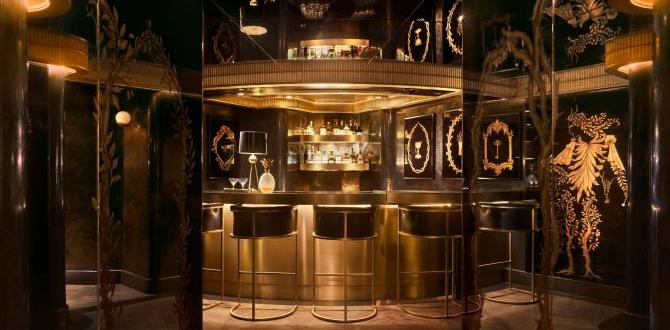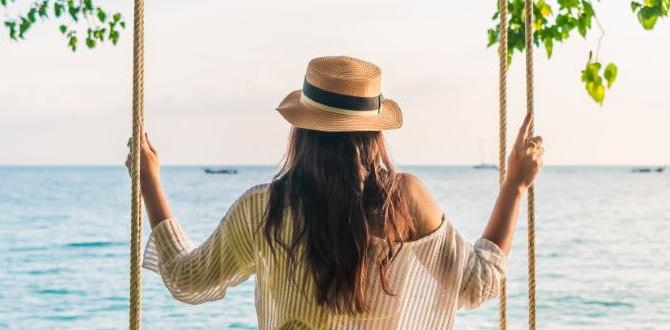Navigating Alexandria, Egypt, is a joy when you know where to go. This guide helps you identify areas to approach with caution and highlights essential, safe zones for tourists and locals alike. Focus on well-trafficked, reputable neighborhoods for a comfortable and secure experience.
Alexandria, Egypt, a city steeped in history and vibrant life, can sometimes feel a little overwhelming for first-time visitors. You might wonder which neighborhoods are best for exploring ancient sites and enjoying the modern buzz, and which ones are perhaps best avoided for safety and peace of mind. It’s completely normal to feel a bit uncertain when arriving in a new place. But don’t worry, figuring this out is easier than you think!
We’re here to guide you. This post will break down Alexandria’s areas, helping you identify places to embrace with confidence and those to approach with a bit more awareness. We’ll focus on practical tips, so your journey is smooth, safe, and full of wonderful discoveries. Get ready to explore Alexandria’s essentials with ease!
Understanding Alexandria’s Neighborhoods
Alexandria is a large, diverse city. Like any major metropolis, it has areas that are bustling centers of tourism and commerce, and others that are more residential or industrial. For travelers, understanding this dynamic is key to having a positive experience. The city’s layout means that attractions, accommodations, and dining are often concentrated in specific districts. Knowing these can help you plan your days efficiently and safely.
The key is to focus on the areas that offer convenience, safety, and access to the experiences you’re seeking. We’ll be looking at popular tourist hubs, historical districts, and areas known for their local charm. Simultaneously, we’ll discuss how to be aware of your surroundings in parts of the city that might present different challenges.
Navigating with Confidence: Essential Alexandria Areas
When you’re planning a trip to a historic city like Alexandria, Egypt, you want to know where the best spots are. These are the areas where you’ll find the most charm, the most historical significance, and the best amenities. We’ll highlight some of these must-visit neighborhoods, where safety and enjoyment are generally high.
The Corniche and Downtown (El Raml)
Alexandria’s famous Corniche is the heart and soul of the city, a long, scenic promenade stretching along the Mediterranean Sea. This is where many of the city’s most iconic sights are located, including the Bibliotheca Alexandrina and the Citadel of Qaitbay. The area around El Raml Square, often considered downtown, is a major hub too.
What to Expect: Bustling cafes, sea views, historic architecture, and easy access to transportation.
Why it’s Essential: This is the postcard view of Alexandria. It’s well-lit, generally patrolled, and packed with hotels, restaurants, and shops catering to visitors. It’s a fantastic place for a stroll, to people-watch, and to soak in the sea breeze. You’ll often find street performers and vendors here, contributing to a lively atmosphere.
Key Attractions: Bibliotheca Alexandrina, Citadel of Qaitbay, Pompey’s Pillar (though slightly inland), various beaches, and numerous seafood restaurants.
Montaza Gardens and Palace
Located on the eastern side of the city, Montaza is a historical royal complex set within beautiful sprawling gardens overlooking the sea. It’s a more relaxed and upscale area, perfect for a day trip to escape the city’s hustle.
What to Expect: Serene natural beauty, stunning architecture, walking paths, and sea vistas.
Why it’s Essential: This area is primarily a public park and a historical attraction. While it’s a bit further out, its well-maintained grounds and palaces offer a safe and picturesque environment. It’s popular with local families and tourists seeking a peaceful retreat. Entrance fees apply for the palace grounds, which help maintain the area.
Gleem and Stanley Bay
These areas along the Corniche are known for their modern vibe, upscale hotels, restaurants, and the iconic Stanley Bridge with its unique lamp posts. They offer a contemporary face of Alexandria.
What to Expect: Trendy cafes, modern architecture, beachfront activities, and a sophisticated atmosphere.
Why it’s Essential: Gleem and Stanley are popular residential and tourist areas. They are generally safe, well-connected, and offer a good selection of amenities. Stanley Bridge, in particular, is a landmark and a popular spot for evening walks and enjoying the city lights.
Sidi Bishr and Bahary (Lower Alexandria)
These districts closer to the historical city center are vibrant and often very crowded, especially during warmer months. Bahary is where the historic Alexandria of the past era is most visible with its older buildings and traditional markets. Sidi Bishr is known for its lively beaches and street food.
What to Expect: Authentic local life, busy markets, street food, and traditional Egyptian atmosphere.
Why it’s Essential: For a taste of real Alexandrian life, these areas are invaluable. They are generally safe during the day and early evening, offering a glimpse into the city’s everyday pulse. Be prepared for crowds and a more sensory experience here. You’ll find the best local eats and a truly authentic feel.
Specific Areas to Approach with Awareness
Alexandria, like any large city, has areas that might be less tourist-friendly or present potential concerns. This isn’t about declaring entire neighborhoods “dangerous,” but rather about understanding where to exercise extra caution or stick to well-trodden paths. These areas are often more residential, industrial, or simply less frequented by tourists, meaning they may have less public infrastructure geared towards visitor safety and comfort.
Industrial and Port ZonesAreas surrounding the Port and industrial districts can be busy with cargo traffic and less welcoming to pedestrians. These zones are primarily functional, not recreational, and may lack the amenities or safety features expected by tourists.
Why to Be Aware: Heavy truck and ship traffic, limited tourist facilities, and potentially a lack of pedestrian-friendly infrastructure. These are working areas, and public access might be restricted in certain parts.
Very Deep Residential Neighborhoods (Away from Tourist Routes)
While many residential areas are perfectly safe, venturing too far into very dense, less developed residential neighborhoods, especially on the outskirts of the city and away from major roads or landmarks, might mean encountering areas with less lighting, fewer public services, and less general oversight typical in tourist zones.
Why to Be Aware: Potentially less lighting at night, fewer police patrols, and surroundings that are not geared towards visitors. It’s always best to stick to areas that are well-populated and have a visible presence of businesses or attractions.
Areas with Limited Evening Activity
Neighborhoods that are primarily residential or commercial during the day but become very quiet and empty at night might require extra caution. Lack of activity can sometimes correlate with less visibility and fewer people around.
Why to Be Aware: Sparse crowds, dim lighting, and fewer open businesses can make these areas feel less secure after dark.
It’s important to remember that these are general observations. Egypt is actively working to improve safety across all its cities. The vast majority of Alexandria is welcoming and safe for visitors. Being aware and informed is the key to a stress-free trip.
Practical Tips for Staying Safe and Comfortable
Beyond understanding the areas, there are everyday practices that can significantly enhance your safety and comfort in Alexandria. These tips are simple, actionable, and applicable no matter where you are in the city.
Transportation Smartly
Use Reputable Taxis or Ride-Sharing Apps: Opt for official airport taxis or well-known ride-sharing services like Uber or Careem. These services often have established pricing or GPS tracking, adding a layer of security. Always ensure the meter is running in traditional taxis, or confirm the price beforehand.
Understand Public Transport: While local buses are common, they can be crowded and confusing for tourists. If you opt for them, be very mindful of your belongings. Trams are also a historic part of Alexandria and can be a scenic way to travel along the Corniche, but they get very full.
Walking: Alexandria is a city best explored partly on foot, especially along the Corniche and in downtown areas. However, be aware of traffic, especially when crossing streets.
Personal Safety Practices
Keep Valuables Secure: Use a money belt or a secure bag. Avoid flashing expensive jewelry or electronics. Be particularly aware in crowded places like markets or on public transport.
Stay Aware of Your Surroundings: This is a universal travel tip. Pay attention to who is around you. If something feels off, it’s okay to move to a more populated or well-lit area.
Trust Your Intuition: If a situation or area feels uncomfortable, don’t hesitate to leave. Your gut feeling is often your best guide.
Learn Basic Arabic Phrases or Use Translation Apps: Knowing a few basic phrases like “hello” (Salam), “thank you” (Shukran), and “no, thank you” (Laa, shukran) can be very helpful. Translation apps are also incredibly useful.
Comfort Essentials for Alexandria
Traveling is about more than just getting from point A to point B; it’s about comfort. Especially in a warm climate like Alexandria’s, having the right essentials can make all the difference.
Stay Hydrated: Carry a reusable water bottle. Staying hydrated is crucial, especially during warmer months.
Sun Protection: A wide-brimmed hat, sunglasses, and high SPF sunscreen are non-negotiable.
Comfortable Footwear: You’ll be doing a lot of walking. Comfortable, broken-in shoes are essential.
Lightweight Clothing: Pack breathable fabrics like cotton and linen.
Personal Care Items: For those who require them, having discreet and comfortable personal care items like adult diapers and pads can provide peace of mind and allow for stress-free exploration. Similarly, for parents traveling with young children, having access to and easy ways to carry child diapers ensures comfort and hygiene on outings. These essentials allow you to focus on enjoying the experience without worry.
Essential Resources and Information
To further boost your confidence and preparedness for visiting Alexandria, here are some reliable resources. They offer valuable, up-to-date information on travel advisories, safety tips, and general guidance for visiting Egypt.
Government Travel Advisories
Official government travel advisories are an excellent source for understanding the current safety situation in any country. They are regularly updated by foreign ministries.
U.S. Department of State – Egypt Travel Advisory: This provides detailed information on safety conditions, local laws, and specific risks. It’s important to check the latest advice before you travel. You can find their comprehensive guide by searching for “US Department of State Egypt Travel Advisory”.
UK Government Foreign Travel Advice for Egypt: Similar to the U.S. advisory, this offers guidance on safety, entry requirements, and local customs. Search for “UK Foreign Travel Advice Egypt” for the latest information.
Local Laws and Customs
Understanding basic local laws and customs can prevent misunderstandings and ensure a respectful visit. Egypt is a Muslim-majority country, and while Alexandria is generally more liberal than some other parts of Egypt, it’s wise to be aware.
Dress Code: While not strictly enforced in all tourist areas like on the Corniche, modest dress is appreciated, particularly when visiting religious sites. For women, covering shoulders and knees is a good practice.
Photography: Always ask permission before photographing individuals, especially women. Be cautious when photographing government buildings or military installations.
Alcohol Consumption: Alcohol is available in hotels and licensed restaurants/bars, but public intoxication is not acceptable.
Emergency Contacts
Knowing who to call in an emergency can be crucial.
Police: The general emergency number in Egypt is 122.
Ambulance: The emergency number for ambulances is 123.
Your Embassy or Consulate: Always have the contact information for your country’s embassy or consulate in Egypt readily available.
Navigating Alexandria: A Comparative Look
To help solidify your understanding, let’s look at a brief comparison of different types of areas in Alexandria. This table highlights key characteristics to guide your planning.
| Area Type | General Atmosphere | Tourist Friendliness | Safety Considerations | Best For |
| Corniche/Downtown | Lively, historic, scenic, busy | Very High | Generally safe, well-patrolled, busy with people | Sightseeing, dining, walking, first-time visitors |
| Montaza Gardens | Peaceful, green, historical, royal | High | Very safe, well-maintained, supervised | Relaxation, nature, historical exploration, family outings |
| Gleem/Stanley | Modern, trendy, upscale, vibrant nightlife | High | Safe, well-lit, good infrastructure | Dining, cafes, enjoying modern Alexandria, evening strolls |
| Sidi Bishr/Bahary | Authentic, local, traditional, crowded, energetic | Moderate | Generally safe during the day/early evening, be aware of crowds | Experiencing local culture, street food, authentic markets |
| Industrial/Port | Functional, busy, transit-oriented | Low | Traffic hazards, limited public access, less tourist-oriented | Not recommended for general tourism |
| Outlying Residences| Varied, can be quiet or dense | Low | Varies; less urban infrastructure, potentially less lighting | Not typically for tourists; best to stay in established neighborhoods |
This comparative table should give you a quick snapshot of what to expect and where to focus your attention for a comfortable and enriching visit to Alexandria.
Conclusion
Alexandria is a city brimming with history, culture, and breathtaking Mediterranean vistas. By understanding its different districts and focusing your explorations on essential, well-established areas like the Corniche, Downtown, Montaza, Gleem, and Stanley, you’re setting yourself up for a comfortable and secure journey. While it’s always wise to be aware and exercise common sense – particularly in less developed or purely functional zones – the city is overwhelmingly welcoming to visitors.
Remember to utilize reputable transportation, keep your valuables secure, and embrace the local rhythm. With a little preparation and awareness, your travels can be filled with the joy of discovery, the taste of delicious seafood, and the awe of ancient wonders. Pack your essentials, stay hydrated, and most importantly, enjoy every moment of your Alexandrian adventure! Safe travels!
Frequently Asked Questions
Q1: Is Alexandria, Egypt, generally safe for tourists?
Yes, Alexandria is generally considered safe for tourists. Like any major city, it has busy tourist areas and might have some less frequented or industrial zones. By staying in well-known areas, using reputable transport, and being aware of your surroundings, you can have a very safe and enjoyable trip.
Q2: What is the best part of Alexandria to stay in for tourists?
For most tourists, staying along the Corniche or in the downtown (El Raml) area is ideal. This puts you close to many major attractions, hotels, restaurants, and offers great sea views and lively atmosphere. Gleem and Stanley are also excellent, more modern options.
Q3: Are there specific areas I should avoid in Alexandria?
You don’t necessarily need to “avoid” entire areas, but it’s wise to be more cautious in industrial zones, far-flung residential areas not on tourist maps, or places that become very deserted at night. Focus on the popular, well-populated districts.
Q4: Is it safe to walk around Alexandria at night?
Walking along the Corniche at night is generally safe due to the presence of people, lights, and cafes. For other areas, stick to well-lit, populated streets with open businesses. Avoid dimly lit or deserted streets, especially if you are unfamiliar with the area.
Q5: How can I get around Alexandria safely?
The safest ways to get around are usually by using reputable taxi companies, ride-sharing apps like Uber or Careem, or by walking in well-trafficked areas. Be mindful of traffic when walking and always confirm taxi fares or ensure the meter is used.
Q6: What if I need to travel with personal care items like diapers?
Finding personal care items is straightforward. Major pharmacies throughout Alexandria will carry a range of products. For specific needs like adult incontinence products, look for larger pharmacies or well-known chains. Similarly, child diapers are readily available in supermarkets and pharmacies, ensuring families can easily manage their needs while traveling through the city.
Q7: What should I do if I encounter a problem or feel unsafe?
Your first step should be to move towards a public place with people or businesses. If it’s a genuine emergency, call the police at 122 or an ambulance at 123. You can also seek assistance from your hotel staff or contact your country’s embassy or consulate if the situation warrants it.




